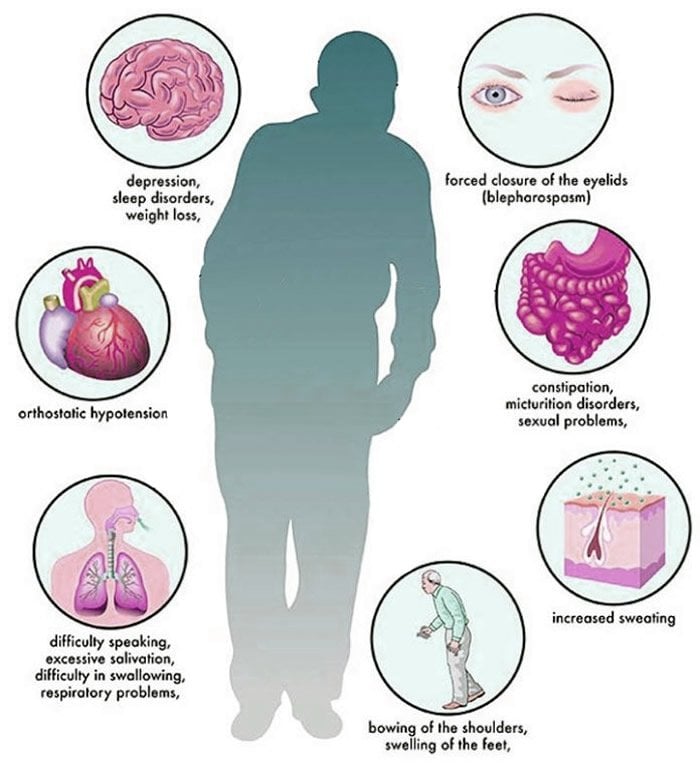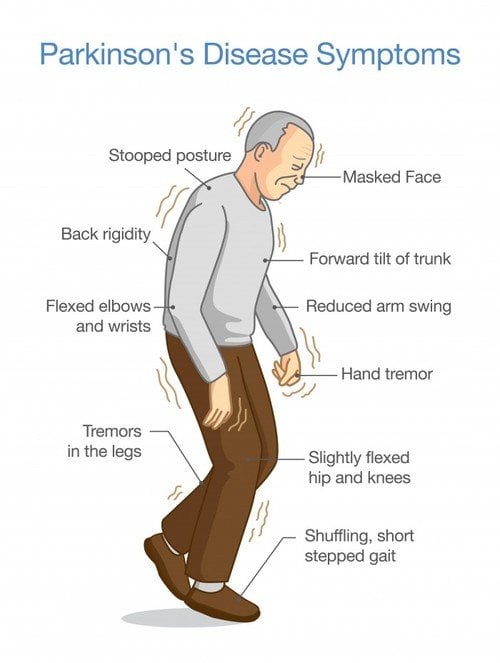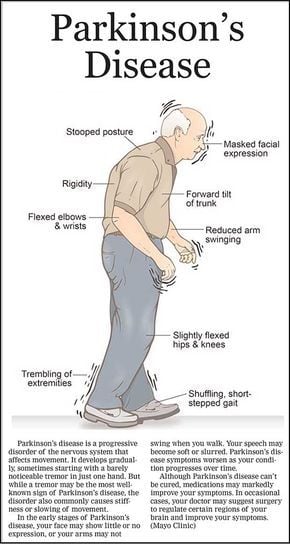What Is The Prognosis And Life Expectancy For Parkinson’s Disease
The severity of Parkinson’s disease symptoms and signs vary greatly from person to peson, and it is not possible to predict how quickly the disease will progress. Parkinson’s disease itself is not a fatal disease, and the average life expectancy is similar to that of people without the disease. Secondary complications, such as pneumonia, falling-related injuries, and choking can lead to death. Many treatment options can reduce some of the symptoms and prolong the quality of life.
Pain Is A Common But Overlooked Problem In Parkinsons Disease
Pain is an often overlooked non-motor symptom of Parkinsons disease . Studies show that between 40-80% of people with PD report pain, which is likely why it is often suggested as a topic for this blog.
One of the reasons why the topic of pain and PD is difficult to address is that it is sometimes tough to discern whether a particular pain is due to PD or not. Chronic pain is such a common symptom among the general population, and people with PD are not immune to common problems as well. However, there are aspects of PD that may exacerbate the pain experienced from a common problem. In addition, there are particular types of pain that may be unique to people with PD.
Painful Symptoms Of Parkinsons Disease
Pain can sometimes be an early symptom of PD. For example, a person may complain of a painful shoulder and be diagnosed with an orthopedic condition such as a frozen shoulder, only to develop a rest tremor on that side at a later point. The painful shoulder was in fact not a frozen shoulder after all, but rather pain due to the rigidity of PD. Now of course, sometimes a frozen shoulder is really just a frozen shoulder, so theres no need to jump to conclusions when you are experiencing pain. Not every ache and pain is a sign of PD, but it is important for you to educate yourself, be aware of the possible connections, and be proactive about seeking medical attention for any notable pain you are experiencing.
If you have PD and develop pain, it is important to first bring this to the attention of your doctor. The pain may be related to your PD, or the pain may be due to a common problem such as arthritis which is exacerbated by your PD. However, in some cases, it may be a symptom of a more serious medical problem. So do not assume that the pain is related to your PD before getting an appropriate medical workup.
Read Also: Loss Of Balance Parkinson Disease
Acting Out What Youre Dreaming
- People with REM sleep behavior disorder might talk in their sleep and flail their arms and legs during dreams, accidentally hitting or kicking a person in the same bed.
When people learn about the sleep disorder, they often say, Ive been doing that for years. Theyre sometimes astonished to learn its an early symptom of Parkinsons, Dr. Joseph says.
What Can You Do If You Have Pd

- Work with your doctor to create a plan to stay healthy. This might include the following:
- A referral to a neurologist, a doctor who specializes in the brain
- Care from an occupational therapist, physical therapist or speech therapist
- Meeting with a medical social worker to talk about how Parkinson’s will affect your life
For more information, visit our Treatment page.
Page reviewed by Dr. Chauncey Spears, Movement Disorders Fellow at the University of Florida, a Parkinsons Foundation Center of Excellence.
Also Check: Parkinson’s Disease Mental Health
How Is Parkinsons Disease Diagnosed
Diagnosing Parkinsons disease is sometimes difficult, since early symptoms can mimic other disorders and there are no specific blood or other laboratory tests to diagnose the disease. Imaging tests, such as CT or MRI scans, may be used to rule out other disorders that cause similar symptoms.
To diagnose Parkinsons disease, you will be asked about your medical history and family history of neurologic disorders as well as your current symptoms, medications and possible exposure to toxins. Your doctor will look for signs of tremor and muscle rigidity, watch you walk, check your posture and coordination and look for slowness of movement.
If you think you may have Parkinsons disease, you should probably see a neurologist, preferably a movement disorders-trained neurologist. The treatment decisions made early in the illness can affect the long-term success of the treatment.
Is Parkinsons Disease Inherited
Scientists have discovered gene mutations that are associated with Parkinsons disease.
There is some belief that some cases of early-onset Parkinsons disease disease starting before age 50 may be inherited. Scientists identified a gene mutation in people with Parkinsons disease whose brains contain Lewy bodies, which are clumps of the protein alpha-synuclein. Scientists are trying to understand the function of this protein and its relationship to genetic mutations that are sometimes seen in Parkinsons disease and in people with a type of dementia called Lewy body dementia.
Several other gene mutations have been found to play a role in Parkinsons disease. Mutations in these genes cause abnormal cell functioning, which affects the nerve cells ability to release dopamine and causes nerve cell death. Researchers are still trying to discover what causes these genes to mutate in order to understand how gene mutations influence the development of Parkinsons disease.
Scientists think that about 10% to 15% of persons with Parkinsons disease may have a genetic mutation that predisposes them to development of the disease. There are also environmental factors involved that are not fully understood.
Read Also: Everything You Need To Know About Caregiving For Parkinson’s Disease
Treating Parkinsons With Complementary Medicine
Complementary medicine incorporates many different practices that can be used alongside conventional medicine to try to ease PD symptoms. There is typically not as much rigorous data to support the use of complementary medicine techniques, as compared to conventional medicine, but many patients find them helpful. These include yoga and massage.
Is Parkinsons Disease Fatal
Parkinsons disease itself doesnt cause death. However, symptoms related to Parkinsons can be fatal. For example, injuries that occur because of a fall or problems associated with dementia can be fatal.
Some people with Parkinsons experience difficulty swallowing. This can lead to aspiration pneumonia. This condition is caused when foods, or other foreign objects, are inhaled into the lungs.
Don’t Miss: Anxiety And Parkinson’s Disease
How Is Parkinsons Diagnosed
No one test or scan can diagnose Parkinsons disease. Doctors look for four classic symptoms before reaching a PD diagnosis: tremors, rigidity in the wrist and elbow joints, lack or slowness of movement, and unstable posture.
Disease state and progression of PD is measured through a motor exam using the Unified Parkinsons Disease Rating Scale , a tool that evaluates factors such as reflexes, tremor, coordination, balance, posture, rigidity, gait, eye movement, mental functioning, mood and social interaction. Brain scans also may be used to assess activity and function of brain regions involved in movement and can help rule out other conditions such as stroke or brain tumor. Scientists continue to gain greater understanding of PD through continued research to develop better treatments and a potential cure for the disease.
How Is It Treated
At this time, there is no cure for Parkinson’s disease. But there are several types of medicines that can control the symptoms and make the disease easier to live with.
You may not even need treatment if your symptoms are mild. Your doctor may wait to prescribe medicines until your symptoms start to get in the way of your daily life. Your doctor will adjust your medicines as your symptoms get worse. You may need to take several medicines to get the best results.
Levodopa is the best drug for controlling symptoms of Parkinson’s. But it can cause problems if you use it for a long time or at a high dose. So doctors sometimes use other medicines to treat people in the early stages of the disease.
The decision to start taking medicine, and which medicine to take, will be different for each person. Your doctor will be able to help you make these choices.
In some cases, a treatment called deep brain stimulation may also be used. For this treatment, a surgeon places wires in your brain. The wires carry tiny electrical signals to the parts of the brain that control movement. These little signals can help those parts of the brain work better.
There are many things you can do at home that can help you stay as independent and healthy as possible. Eat healthy foods. Get the rest you need. Make wise use of your energy. Get some exercise every day. Physical therapy and occupational therapy can also help.
You May Like: Does Parkinson’s Cause Neuropathy
Parkinsons Early Signs & Symptoms
Due to the complexity of the disease, a diagnosis of PD is based on a variety of factors. Parkinsons early signs include a wide range of cognitive, mood and motor symptoms.
- Difficulty walking, the inability to walk naturally or swing ones arms is an early symptom of PD. People with PD also may take short, uneven steps , suffer from freezing spells, as well as experience difficulty judging obstacles and negotiating turns and corners.
- Tremors, particularly in the arms or hands. In early stages of the disease, tremor is usually experienced in one limb or on one side of the body, but other parts of the body may be affected as the disease progresses.
- Bradykinesia is the gradual degradation of movement caused by the brains lethargy in transmitting instructions to the desired parts of the body. Bradykinesia can affect facial muscles that may give the sufferer a mask-like appearance.
- Trouble with balance can be an early warning symptom of PD.
- Depression is common for people with PD.
- Loss of fine motor skills.
- Loss of sense of smell.
- Changes in handwriting, either shaky handwriting or writing smaller than usual.
- Changes in voice and speech patterns, such as softening voice or difficulty enunciating.
- Trouble sleeping or REM Sleep Behavior Disorder , which causes people to act out dreams.
- Memory loss, trouble problem-solving or decline in mental abilities.
- Skin disorders such as dry rough skin or dandruff.
Environmental Factors And Exposures

Exposure to pesticides and a history of head injury have each been linked with PD, but the risks are modest. Never having smoked cigarettes, and never drinking caffeinated beverages, are also associated with small increases in risk of developing PD.
Low concentrations of urate in the blood is associated with an increased risk of PD.
Drug-induced parkinsonism
Different medical drugs have been implicated in cases of parkinsonism. Drug-induced parkinsonism is normally reversible by stopping the offending agent. Drugs include:
Recommended Reading: Early Parkinson’s Symptoms Mayo Clinic
Discuss With Your Physician
Non-motor symptoms can sometimes be difficult to recognize. Therefore, it is important to make your doctor aware of them.
One useful resource is the PD NMS Questionnaire. You can use this to record your symptoms and discuss them with your doctor.
Dr. Ron Postuma, whose research was funded by donations to the Parkinson Canada Research Program, has also developed tools to help people with Parkinsons and their physicians identify and manage non-motor symptoms.
What Are The Primary Motor Symptoms Of Parkinsons Disease
There are four primary motor symptoms of Parkinsons disease: tremor, rigidity, bradykinesia and postural instability . Observing two or more of these symptoms is the main way that physicians diagnose Parkinsons.
It is important to know that not all of these symptoms must be present for a diagnosis of Parkinsons disease to be considered. In fact, younger people may only notice one or two of these motor symptoms, especially in the early stages of the disease. Not everyone with Parkinsons disease has a tremor, nor is a tremor proof of Parkinsons. If you suspect Parkinsons, see a neurologist or movement disorders specialist.
Tremors
Rigidity
Bradykinesia
Postural Instability
Walking or Gait Difficulties
Dystonia
Vocal Symptoms
Also Check: What Are The Complications Of Parkinson’s Disease
Theories About What Causes Parkinsons
The cause of Parkinsons disease is still unknown, although there is some evidence for the role of genetics, environmental factors, or a combination of both. It is also possible that there may be more than one cause of the disease. Scientists generally believe that both genetics and environment interact to cause Parkinsons disease in most people who have it.
Currently, there is an enormous amount of research directed at producing more answers about what causes Parkinsons disease and how it might be prevented or cured. When physicians diagnose Parkinsons, they often describe it as idiopathic . This simply means that the cause of the disease is not known.
Determining Diagnosis Through Response To Parkinsons Medication
If a persons symptoms and neurologic examination are only suggestive of Parkinsons disease or if the diagnosis is otherwise in doubt, the physician may, nevertheless, prescribe a medication intended for Parkinsons disease to provide additional information. In the case of idiopathic Parkinsons, there is typically a positive, predictable response to Parkinsons disease medication in the case of some related Parkinsonian syndromes, the response to medication may not be particularly robust, or it may be absent entirely.
Unfortunately, there are no standard biological tests for the disease, such as a blood test. However, researchers are actively trying to find biomarkers in blood and other bodily fluids that could help confirm the diagnosis.
Also Check: Parkinson’s Support Group For Caregivers
What Are The Different Stages Of Parkinsons Disease
Each person with Parkinsons disease experiences symptoms in in their own unique way. Not everyone experiences all symptoms of Parkinsons disease. You may not experience symptoms in the same order as others. Some people may have mild symptoms others may have intense symptoms. How quickly symptoms worsen also varies from individual to individual and is difficult to impossible to predict at the outset.
In general, the disease progresses from early stage to mid-stage to mid-late-stage to advanced stage. This is what typically occurs during each of these stages:
Early stage
Early symptoms of Parkinsons disease are usually mild and typically occur slowly and do not interfere with daily activities. Sometimes early symptoms are not easy to detect or you may think early symptoms are simply normal signs of aging. You may have fatigue or a general sense of uneasiness. You may feel a slight tremor or have difficulty standing.
Often, a family member or friend notices some of the subtle signs before you do. They may notice things like body stiffness or lack of normal movement slow or small handwriting, lack of expression in your face, or difficulty getting out of a chair.
Mid stage
Mid-late stage
Standing and walking are becoming more difficult and may require assistance with a walker. You may need full time help to continue to live at home.
Advanced stage
What Causes Parkinsons Disease
Parkinsons disease occurs when nerve cells in an area of the brain called the substantia nigra become impaired or die. These cells normally produce dopamine, a chemical that helps the cells of the brain communicate . When these nerve cells become impaired or die, they produce less dopamine. Dopamine is especially important for the operation of another area of the brain called the basal ganglia. This area of the brain is responsible for organizing the brains commands for body movement. The loss of dopamine causes the movement symptoms seen in people with Parkinsons disease.
People with Parkinsons disease also lose another neurotransmitter called norepinephrine. This chemical is needed for proper functioning of the sympathetic nervous system. This system controls some of the bodys autonomic functions such as digestion, heart rate, blood pressure and breathing. Loss of norepinephrine causes some of the non-movement-related symptoms of Parkinsons disease.
Scientists arent sure what causes the neurons that produce these neurotransmitter chemicals to die.
Read Also: Cbd Dosage For Parkinson’s
If You Develop A Tremor
Urgent medical care isn’t needed if you’ve had a tremorâshaking or tremblingâfor some time. But you should discuss the tremor at your next doctor’s appointment.
If a tremor is affecting your daily activities or if it’s a new symptom, see your doctor sooner.
A written description will help your doctor make a correct diagnosis. In writing your description, consider the following questions:
- Did the tremor start suddenly or gradually?
- What makes it worse or better?
- What parts of your body are affected?
- Have there been any recent changes in the medicines you take or how much you take?
When To See Your Doctor

Its easy to assume these problems have other causes, and they often do. But any of these non-motor symptoms can have a big impact on your overall quality of life.
Having one or more doesnt necessarily mean you have Parkinsons disease or that youll eventually develop it. But its worth consulting with your doctor.
Tell your doctor if youre concerned about having Parkinsons disease. Although theres no cure, there are medications to help control symptoms.
Recommended Reading: Green Tea For Parkinson’s
How Is Parkinson’s Disease Diagnosed
Your doctor will ask questions about your symptoms and your past health and will do a neurological exam. This exam includes questions and tests that show how well your nerves are working. For example, your doctor will watch how you move, check your muscle strength and reflexes, and check your vision.
Your doctor will also ask questions about your mood.
In some cases, your doctor may have you try a medicine. How this medicine works may help your doctor know if you have Parkinson’s disease.
There are no lab or blood tests that can help your doctor know whether you have Parkinson’s. But you may have tests to help your doctor rule out other diseases that could be causing your symptoms. For example, you might have an MRI to look for signs of a stroke or brain tumor.